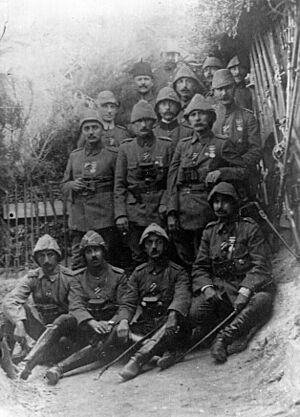Mehmet Esat Bülkat facts for kids
Quick facts for kids
Mehmet Esat Bülkat
|
|
|---|---|

Mehmed Esad Pasha in 1915
|
|
| Birth name | Mehmed Esad Pasha |
| Born | 18 October 1862 Yanya, Ioannina Eyalet, Ottoman Empire (modern Ioannina, Greece) |
| Died | 2 November 1952 (aged 90) Istanbul, Turkey |
| Allegiance | Ottoman Empire |
| Service/ |
Ottoman Army |
| Years of service | 1884–1919 |
| Rank | Lieutenant general |
| Battles/wars |
|
| Relations | Mehmet Emin Efendi (Father), Wehib Pasha (Brother), Mehmet Nakyettin Bey (Brother), Kâzim Taşkent (Nephew), Doğan Kardeş (great nephew) |
Mehmet Esat Bülkat (born October 18, 1862 – died November 2, 1952) was an important officer in the Ottoman Army. He fought in major wars like the First Balkan War and World War I. During the Balkan War, he led the Yanya Corps. In World War I, he was a senior commander in the famous Gallipoli campaign. Before 1934, he was known as Mehmed Esad Pasha. The title "Pasha" was given to high-ranking military officers in the Ottoman Empire.
Early Life and Education

Mehmed Esad was born in Yanya (now Ioannina, Greece) on October 18, 1862. His family was Albanian and his father, Mehmed Emin Efendi, was the mayor of the city. Esad's younger brother, Wehib Pasha, also became a well-known general.
Esad spent his first 17 years in Yanya. In 1880, he went to the Kuleli Military High School in Monastir (modern Bitola, North Macedonia). Even though he was smart, he struggled in his first year because he didn't understand Ottoman Turkish very well. At that time, people in Yanya mostly spoke Greek. So, Esad took extra lessons to improve his Turkish.
After getting better at Turkish, Esad attended the Ottoman Military Academy. He was a brilliant student and graduated at the very top of his class in 1884.
Military Career
After serving in a regular army unit, Esad was chosen for the Ottoman Military College in 1887. He graduated again as the top student in 1890, becoming a General Staff officer.
His excellent performance led him to further military training in Germany. He studied at the Prussian War Academy in Berlin and spent time with German army units. During his four years in Germany, he learned to speak German fluently.
When he returned to the Ottoman Empire in May 1894, Esad joined the Intelligence Division of the General Staff. He was promoted to Lieutenant Colonel. However, he didn't enjoy working there, so a year later, he became a teacher at the Ottoman Military College.
He took a break from teaching to serve as Chief of Staff for the 1st Infantry Division during the Greco-Turkish War of 1897. After the war, he returned to the college and became its dean of academics in 1899. One of his students was Mustafa Kemal, who would later become the founder of modern Turkey. Because of his success in military education, Sultan Abdul Hamid II noticed him. Esad was promoted to Major General in 1901 and then to Lieutenant General in 1906.
In 1907, he was made Acting Commander of the Third Army in Thessaloniki. At this time, many young officers were secretly working against Sultan Abdul Hamid II's rule. Even though his brother Wehib was involved, Esad stayed out of politics. This made the Sultan unhappy, and Esad was dismissed from duty a year later.
After the Young Turk Revolution succeeded, Esad was treated as someone from the old government and was demoted. However, his loyalty was eventually recognized. In December 1910, he was given command of the 5th Regular Division stationed at Gelibolu on the Gallipoli Peninsula. Three months later, he commanded the II Army Corps. After a year, he was sent to his hometown of Yanya to command the 23rd Regular Division.
First Balkan War
When the First Balkan War began, Esad was put in charge of the new Yanya Corps. His job was to defend the well-protected city of Yanya and the wider region of Epirus. He used his limited resources wisely and defended Yanya for three months against the Greek Army. He launched constant counter-attacks. However, after the Battle of Bizani in March 1913, he was forced to surrender.
Esad was a prisoner of war in Greece until December 1913. His strong defense of Yanya made him a popular hero, and he earned the special title of "Pasha." Even though he lost, Esad learned a lot about modern warfare, especially how important good defense is. He also became very careful in battle, believing that his soldiers' lives should only be risked if it led to lasting results.
III Corps
Soon after returning from captivity, Esad was praised for his defense of Yanya. He was also able to keep his position when many other officers were removed from the army. In December 1913, he was appointed commander of the III Corps.
Esad was determined to fix the problems that appeared during the Balkan Wars. He was a demanding leader but also kind and forgiving. He believed in training and guiding his officers rather than just punishing them. If an officer wasn't doing well, he would give them a second chance. But if they still struggled, he would replace them. By September 1914, he had replaced many officers, including his chief of staff.
Esad's ability to find and train good officers, combined with the battle experience of his soldiers, made the III Corps one of the best fighting units in the Ottoman Army. He also paid close attention to how his command was managed and supplied. Because of this, when the Ottoman Army prepared for World War I in August 1914, the III Corps was the only one ready on time.
World War I

The III Corps, with about 43,000 soldiers, was given the job of strengthening the Gallipoli Peninsula and the nearby coast. Their mission was to defend against enemy landings. Esad moved his headquarters to the Dardanelles on November 2, 1914.
The III Corps was so well-regarded that its units were often moved to help in other crisis areas. For example, one battalion was sent to Basra to protect against a threat there. During the early days of World War I, the 8th Division of the III Corps was sent to Syria. Esad quickly formed a new 19th Division from other units to replace it.
Most stories about the Gallipoli Campaign focus on the German General Liman von Sanders and Esad's subordinate, Mustafa Kemal. However, it was Esad who prepared the Ottoman defenses before the battle. Although he struggled with the command confusion during the first Allied landing on April 25, 1915, he played a very important role in leading the Ottoman Army for the rest of the Gallipoli campaign.
After the Gallipoli campaign, Esad was promoted back to Lieutenant General in September 1915. However, he was not given any other active command roles by Enver Pasha, a powerful leader. In November 1915, Esad was appointed commander of the First Army. In this role, he mostly trained new soldiers for other commands and performed official duties.
In late 1917, Esad visited Germany and toured the German battlefronts.
In February 1918, he was placed in command of the Fifth Army, and then in June of the same year, he commanded the Third Army on the Caucasus front. However, there wasn't much time for him to take part in operations before the Armistice of Mudros ended the fighting.
During the time after the war (1918–1922), Esad was the Inspector-General of the mostly demobilized Second Army and military schools. But this position existed mostly on paper. Believing he wouldn't get any important roles, he retired from the army in November 1919.
In 1920, Esad briefly served as Navy Minister in a government that quickly resigned after the Allied forces occupied Istanbul. He then joined the forces of Mustafa Kemal and took part in the Turkish War of Independence.
In 1934, when Turkey passed a law requiring everyone to have a surname, he chose "Bülkat."
In his retirement, he wrote two books that were not published during his lifetime: "Çanakkale Hatıraları" (Dardanelles Memories) and "1912–1913 Balkan War." A selection of his memories was published in 1975.
Mehmet Esat Bülkat died in Istanbul on November 2, 1952, and was buried in the Karacaahmet Cemetery.

